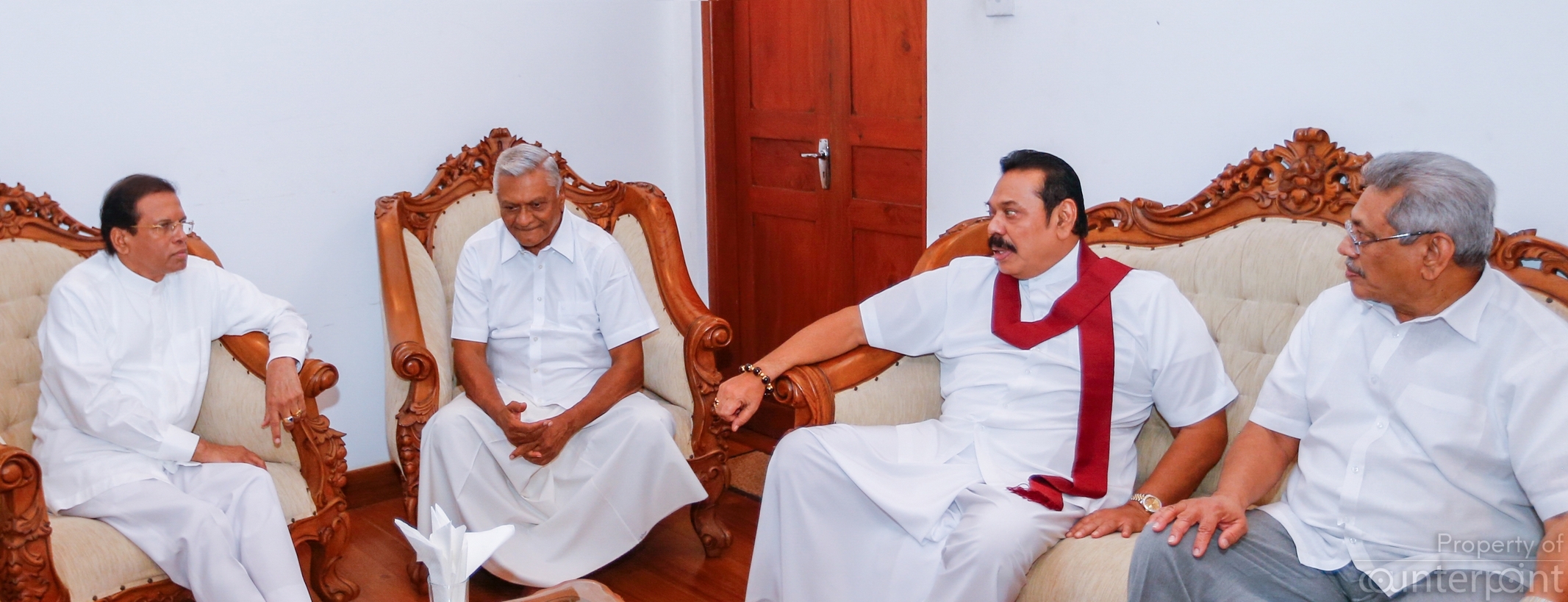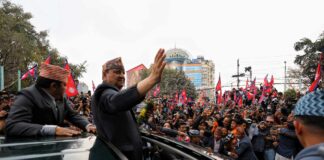
Speculation is rife in political circles that a caretaker government with the Joint Opposition (JO) and the SLFP/UPFA as parties thereto is in the offing. Weekly political columns are replete with juicy accounts of the JO big guns and President Maithripala Sirisena rendezvousing. It is said that former President Mahinda Rajapaksa and President Maithripala Sirisena have had several rounds of talks on rapprochement, albeit without much success. Former Minister Basil Rajapaksa and President Sirisena have also powwowed though they are sworn political enemies, we are told. However, the dramatis personae, when accosted by journalists, give evasive answers to queries about their moves to forge an alliance.
The National Unity Government is a misnomer, for the ruling coalition’s unity is conspicuous by its absence. The cold war between President Sirisena and Prime Minister Ranil Wickremesinghe has come to a head with their parties locking horns at Cabinet meetings. The two leaders themselves had a heated argument last Tuesday, and the Prime Minister skipped the National Economic Council meeting at the Presidential Secretariat. They apparently see eye to eye only on the need to hold their mutual enemy, the JO, at bay.
Troubled political marriage
The political marriage between the SLFP and the UNP would have been free from trouble if President Sirisena had refrained from taking over the SLFP and honoured his promise not to seek a second term. The UNP agreed to field him as the Opposition’s common presidential candidate in the hope that he would help topple the Rajapaksa government, function as the President and then retire after serving the first term. But politics is full of unexpected turns.
President Sirisena had to take over the reins of the SLFP for two reasons. He saw through the UNP’s strategy and realised that his position as the President would be vulnerable without a party to lean on. He also had to grab the SLFP leadership as there was no other way of wresting control over Parliament. If he had not done so he would not have been able to form an interim administration with UNP leader Ranil Wickremesinghe as the PM. But that move made the President less dependent on the UNP and fuelled his political ambitions and created an alternative power centre in the yahapalana camp. That was not something the UNP had bargained for and its plans went awry.
The UNP cannot run away from the next presidential election. It has not been able to field a party member as a presidential candidate since 2010. It has failed to secure the presidency for nearly 25 years! It, therefore, has to contest the next presidential election and, therefore, it will not agree to field any outsider as the presidential candidate again. Thus, it is thought that the only option Sirisena is left with in realising his goal of securing a second term is to break ranks with the UNP and form a government together with the JO on the condition that he be made the next presidential candidate.
Sirisena’s dilemma
President Sirisena is now in an unenviable position leading the very party he once crippled to achieve his political ambitions. He left the SLFP to become the President and brought down an SLFP-led government to consolidate his powers in January 2015. Thereafter, he ruined the SLFP’s chances of winning a general election seven months later to prevent Mahinda Rajapaksa from securing premiership. Ironically, he has been saddled with the uphill task of steering the SLFP to victory at elections!
Is Sirisena making overtures to the JO/SLPP so as to increase its bargaining power in dealing with the UNP? This is also a possibility in that the UNP is not prepared for the collapse of the yahapalana administration at this juncture. It stands to gain from a division in the SLFP/UPFA at a presidential election. But the PC polls will have to be held before a national level election and the UNP and the SLFP/UPFA will have to clash again at the expense of their fragile unity. Above all, the UNP will have to sever links with the SLFP in time for the next presidential election. So, Sirisena will gain little even if he manages to bargain with the UNP from a position of strength at present.
Leading the SLFP/UPFA at the next Provincial Council polls is a worrisome proposition for President Sirisena, given the ignominious defeat of his party at the February 10 local government polls. Another drubbing will enable the JO/SLPP to eat into the SLFP vote bank further, rendering the President’s position even more vulnerable. So, the best option available for President Sirisena appears to be forging an alliance with the JO/SLPP without further delay. But the JO/SLPP does not look keen to close ranks with the SLFP.

Odds in favour of UNP
The success of the proposed caretaker government project hinges on the ability of the SLFP and the JO to secure at least 113 seats in the House. The UNP needs only six or seven seats to muster a working majority. There is the likelihood of some SLFP Ministers defecting to the UNP in case of the President pulling out of the yahapalana government.
The UNP’s rank and file are not well disposed towards the yahapalana administration, which, they think, has not looked after their interests and benefitted only their SLFP counterparts. They are demoralized beyond measure as a result. They will welcome the formation of a UNP government and are likely carry out their party’s next election campaign with renewed vigour in such an eventuality.
The SLFP/UPFA may end up being a political orphan when the UNP ditches it sooner or later. The JO/SLPP is aware that the SLFP cannot avert a political checkmate, given the dicey situation it finds itself in. It is playing a waiting game.
The JO’s quandary
The SLPP has been able to perform so well electorally because the people, disillusioned with the government, consider it an alternative to the parties in the yahapalana coalition, especially the SLFP and the UNP. It will only sully its image and ruin things for itself if it joins forces with the SLFP.
There is no way the SLFP can absolve itself of the responsibility for the government’s poor economic performance and the attendant public woes. It, therefore, will not be a political asset to the JO/SLPP as such. The mere talk of a possible coming together of the JO/SLPP and the SLFP has prompted some JO stalwarts to let out a howl of protest. Former Minister Kumara Welgama, who is one of the few SLFP dissidents who had the courage to take on President Sirisena and the UNP and declare their allegiance to the defeated President Mahinda Rajapaksa in January 2015, has vehemently opposed the idea of a caretaker government. He has threatened to sit in the Opposition in such an eventuality. He is not alone in voicing protest.
If the JO/SLPP and the SLFP were to form an electoral alliance, President Sirisena would have to be made the next presidential candidate. The presidency is without most of the powers it used to have and the Prime Minister is more powerful than the president thanks to the 19th Amendment. But the President remains a force to be reckoned with and, therefore, attractive to the Rajapaksas. If the JO/SLPP can win the next parliamentary and presidential polls under its own steam, then the members of the Rajapaksa family will be able to become the President, the Prime Minister and the Speaker. Some of the key ministerial positions will also be held by the Rajapaksas’. Therefore, it is not likely that the Rajapaksas will go out of their way bail out Sirisena and the SLFP.
The cat-and-dog life of the UNP and the SLFP is likely to last though there is no love lost between them. They are not yet ready to ditch each other. They are still in two minds and the JO/SLPP is waiting for President Sirisena to stew in his own juice. The Rajapaksas are getting ready for the PC polls.
Assassination plot and India
A flare-up of tension between the SLFP and the UNP at Tuesday’s Cabinet meeting over a proposal to hand over the East Container Terminal to India, made President Sirisena take up issue of an alleged conspiracy to kill him. The media quoted him as having claimed that the RAW was involved in the alleged plot, unbeknownst to Prime Minister Modi. He referred to the arrest of an Indian national in connection with the alleged assassination plot. He touched a raw nerve in New Delhi and promptly denied having referred to the RAW. He even had to speak with PM Narendra Modi himself over the phone in a bid to put the matter to rest.

The government has sought to have the public believe that the media reports on a clash between the Prime Minister and the President at the Cabinet meeting are also baseless. This is not the first time it has tried to do so. It is only papering over the cracks.
The assassination saga has taken a dramatic turn with DIG Nalaka de Silva, the prime suspect, being interdicted. Government efforts to make light of the conspiracy have failed. It was first thought that the SLFP was piling on the agony for political reasons, but even those who previously refused to take the plot issue seriously are beginning to wonder whether there is more to it than meeting the eye. Never a dull day in Sri Lanka!


 Logging you in...
Logging you in... Loading IntenseDebate Comments...
Loading IntenseDebate Comments...

